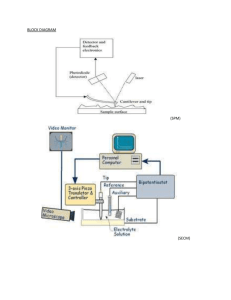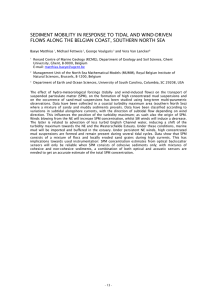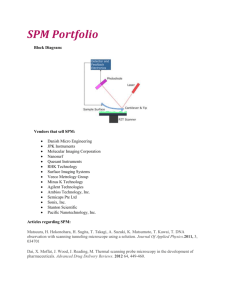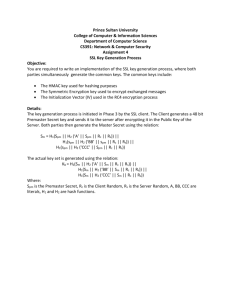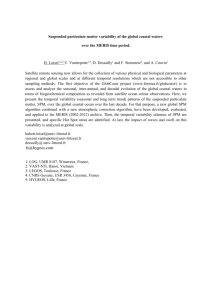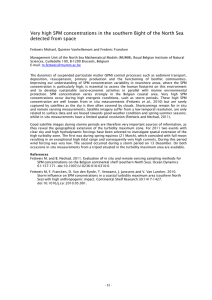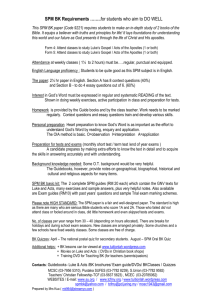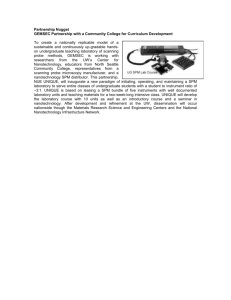TIDALITES 2008, Qingdao (China), September 24-27
advertisement
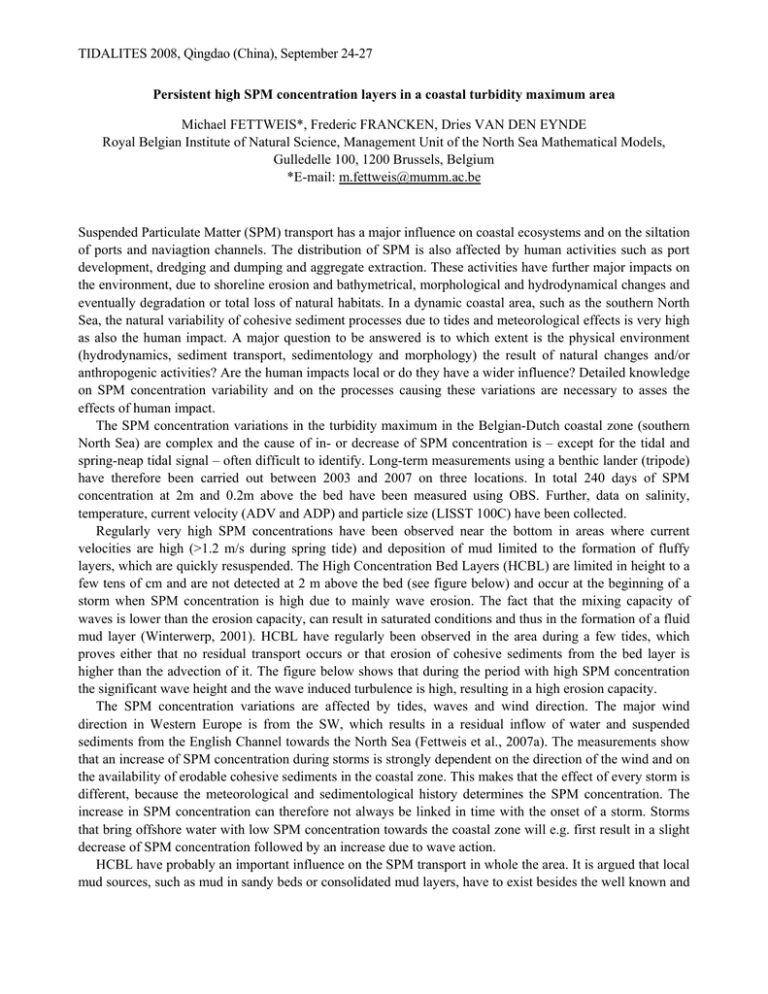
TIDALITES 2008, Qingdao (China), September 24-27 Persistent high SPM concentration layers in a coastal turbidity maximum area Michael FETTWEIS*, Frederic FRANCKEN, Dries VAN DEN EYNDE Royal Belgian Institute of Natural Science, Management Unit of the North Sea Mathematical Models, Gulledelle 100, 1200 Brussels, Belgium *E-mail: m.fettweis@mumm.ac.be Suspended Particulate Matter (SPM) transport has a major influence on coastal ecosystems and on the siltation of ports and naviagtion channels. The distribution of SPM is also affected by human activities such as port development, dredging and dumping and aggregate extraction. These activities have further major impacts on the environment, due to shoreline erosion and bathymetrical, morphological and hydrodynamical changes and eventually degradation or total loss of natural habitats. In a dynamic coastal area, such as the southern North Sea, the natural variability of cohesive sediment processes due to tides and meteorological effects is very high as also the human impact. A major question to be answered is to which extent is the physical environment (hydrodynamics, sediment transport, sedimentology and morphology) the result of natural changes and/or anthropogenic activities? Are the human impacts local or do they have a wider influence? Detailed knowledge on SPM concentration variability and on the processes causing these variations are necessary to asses the effects of human impact. The SPM concentration variations in the turbidity maximum in the Belgian-Dutch coastal zone (southern North Sea) are complex and the cause of in- or decrease of SPM concentration is – except for the tidal and spring-neap tidal signal – often difficult to identify. Long-term measurements using a benthic lander (tripode) have therefore been carried out between 2003 and 2007 on three locations. In total 240 days of SPM concentration at 2m and 0.2m above the bed have been measured using OBS. Further, data on salinity, temperature, current velocity (ADV and ADP) and particle size (LISST 100C) have been collected. Regularly very high SPM concentrations have been observed near the bottom in areas where current velocities are high (>1.2 m/s during spring tide) and deposition of mud limited to the formation of fluffy layers, which are quickly resuspended. The High Concentration Bed Layers (HCBL) are limited in height to a few tens of cm and are not detected at 2 m above the bed (see figure below) and occur at the beginning of a storm when SPM concentration is high due to mainly wave erosion. The fact that the mixing capacity of waves is lower than the erosion capacity, can result in saturated conditions and thus in the formation of a fluid mud layer (Winterwerp, 2001). HCBL have regularly been observed in the area during a few tides, which proves either that no residual transport occurs or that erosion of cohesive sediments from the bed layer is higher than the advection of it. The figure below shows that during the period with high SPM concentration the significant wave height and the wave induced turbulence is high, resulting in a high erosion capacity. The SPM concentration variations are affected by tides, waves and wind direction. The major wind direction in Western Europe is from the SW, which results in a residual inflow of water and suspended sediments from the English Channel towards the North Sea (Fettweis et al., 2007a). The measurements show that an increase of SPM concentration during storms is strongly dependent on the direction of the wind and on the availability of erodable cohesive sediments in the coastal zone. This makes that the effect of every storm is different, because the meteorological and sedimentological history determines the SPM concentration. The increase in SPM concentration can therefore not always be linked in time with the onset of a storm. Storms that bring offshore water with low SPM concentration towards the coastal zone will e.g. first result in a slight decrease of SPM concentration followed by an increase due to wave action. HCBL have probably an important influence on the SPM transport in whole the area. It is argued that local mud sources, such as mud in sandy beds or consolidated mud layers, have to exist besides the well known and generally accepted English Channel as major source of SPM in the southern North Sea (Fettweis et al., 2007b), in order to obtain sufficient amount of SPM to develop HCBL. Local sources are probably only effective during extreme conditions, their impact is therefore difficult to quantify. In the coastal area consolidated mud layers exist that cannot erode under normal conditions (critical erosion stress >10Pa). Wave forcing may result in failure of the consolidated bed and in the formation of mud pebbles (Jacinto & Le Hir, 2001). Mud pebbles have been found frequently in the area (Fettweis et al. 2007b). 3000 SPM 1 SPM 2 SPM concentration (mg/l) 2500 2000 1500 1000 500 0 10 10.5 11 11.5 12 Time (days) 12.5 13 13.5 14 300 1200 250 1000 200 800 150 600 100 400 50 200 0 TKE per unit volume (kg/ms**2) Sign. wave height (cm) Wave height TKE 0 10 10.5 11 11.5 12 Time (days) 12.5 13 13.5 14 November 2006, Belgian coastal zone (southern North Sea). Above: SPM concentration (SPM1: 0.2 and SPM2: 2.0 m above bed); below: Significant wave height and turbulent kinetic energy per unit volume, derived from ADV current velocity data at 0.2 m above the bed. References Fettweis, M., Nechad, B., Van den Eynde, D. 2007a. An estimate of the suspended particulate matter (SPM) transport in the southern North Sea using SeaWiFS images, in-situ measurements and numerical model results. Continental Shelf Res, 27, 1568-1583. Fettweis, M., Du Four, I., Zeelmaekers, E., Baeteman, C., Francken, F., Houziaux, J.-S., Mathys, M., Nechad, B., Pison, V., Vandenberghe, N., Van den Eynde, D., Van Lancker, V., Wartel, S. 2007b. Mud Origin, Characterisation and Human Activities (MOCHA). Final Scientific Report, Belgian Science Policy, 59pp. Silva-Jacinto, R. Le Hir, P. 2001. Response of stratified muddy beds to water waves. In: Coastal and Estuarine Fine Sediment Processes (McAnally, W.H., Mahta, A.J., eds.). Proceedings in Marine Science, 3, 95-108. Winterwerp, J. 2001. Stratification effects by cohesive and non-cohesive sediment. Journal of Geophysical Research, 106 (C10), 22559-22574.
